Calathea Makoyana (Calathea Peacock Plant): Care and Growing Guide

Calathea Makoyana (also called peacock plant) is a spectacular houseplant that has glossy green, broad, oval leaves with dark green oblong blotches. The undersides of the calathea peacock leaves are a pinkish-red color with similar blotchy patterns. Calathea Makoyana is an easy plant to care for and grow well indoors.
This article is a complete guide to caring for Calathea makoyana. At the end of the article, you’ll find helpful growing tips on resolving common care issues with peacock plants.
What is Peacock Plant (Calathea Makoyana)?
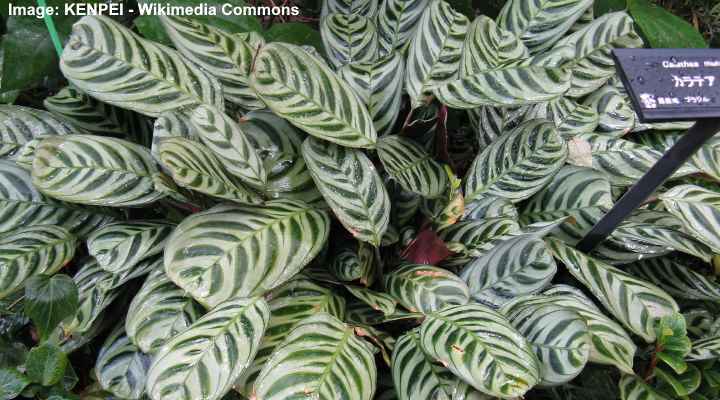
Peacock plant (Calathea makoyana) is grown indoors for its ornamental patterned foliage
Peacock plants (Calathea makoyana) are native to the warm tropical climates in South America. The flowering foliage plant grows on the forest floor, where it thrives in dappled sunlight and humid conditions. In their native environment, Calathea makoyana plants grow in a temperature range between 70°F and 75°F (22°C – 24°C).
Calathea makoyana adapts well to growing indoors. Thankfully, you don’t have to turn your home into a humid jungle to grow this species as a houseplant. Average household temperature is ideal for potted Calathea plants if you increase the humidity.
Peacock plants are mainly grown as houseplants for their decorative foliage. Calathea makoyana has large oval pale green leaves that have dark green patterns. Each leaf has a central green vein with dark green oblong shapes and thin lines stretching to the green edges. The undersides of the peacock plant leaves have dark purple to red colors with similar patterns to the leaf’s upper sides.
How to Care for a Calathea Makoyana – Overview
To care for peacock plants (Calathea makoyana), grow them in bright indirect light, protected from direct sunshine. Peacock plants thrive in a well-draining potting mix and need water when the soil partially dries. Keep the peacock plants in average room temperatures and ensure that humidity is at least 60%. Fertilize monthly with a diluted houseplant fertilizer during the growing season.
Calathea Plants and Prayer Plants
Plants in the Calathea genus are sometimes referred to as prayer plants because they raise their leaves at night like prayer plants in a process called nyctinasty. In the evening, the leaves of calathea plants fold upright at the base of the stem, as if the plant is folding its leaves upward to pray.
Plants in the Calathea and Maranta genera have broad oval leaves with fascinating variegation. Both plant genera are plants in the family Marantaceae and have similar characteristics and care requirements.
Facts About Calathea Peacock
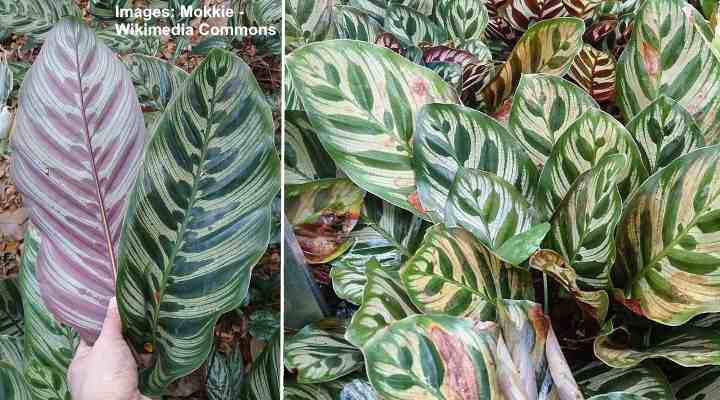
Growing indoors, calathea makoyana usually reaches 2 ft. (0.6 m) tall
The common name of Calathea makoyana—peacock plant—comes from its beautiful leaves that are said to resemble a beautiful peacock’s tail. This Calathea species is also called “cathedral windows” due to its interesting leaf patterns.
Peacock plants are shade plants with a slow to medium growth rate. Growing in pots indoors, Calathea peacock plants don’t grow taller than 2 ft. (0.6 m) tall. They naturally have a bushy growth habit, so you don’t need to prune them to encourage faster growth.
Peacock Plant Flowers
Calathea makoyana plants produce purple and white flowers when grown in the right conditions. The tiny flowers grow in small flower clusters on the ends of stems between the large leafy foliage. It is rare that peacock plants flower indoors. However, their inflorescences are insignificant compared to the plant’s stunning patterned leaves.
Calathea Makoyana — Peacock Plant Care
Calathea makoyana plants are generally low-maintenance houseplants. The easy-care plants need medium to low light, moist soil that is never soggy, and plenty of humidity. If you get these three care aspects right, your peacock plant will continue to grow stunning leaves year on year.
Let’s look in more detail at how to care for Calathea peacock plants at home.
Light Requirements for Growing Calathea Makoyana Indoors
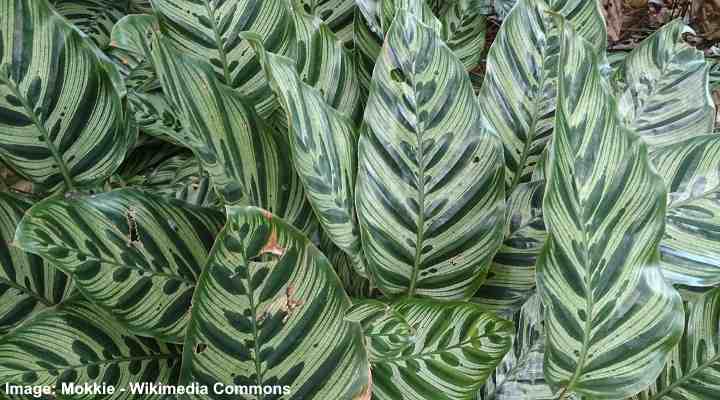
To care properly for your Calathea makoyana indoors, place it in a bright indirect light
To grow peacock plants indoors, place your Calathea makoyana plant pot in bright light but protected from direct sunlight. Calathea species grow in dappled sunlight on the forest flower. The Calathea houseplants will grow best beside an east- or north-facing window. In other rooms, keep the plants behind a sheer curtain to protect them from direct sunlight.
Although peacock plants grow well in shade or low-light conditions, they grow faster in brighter light. You may also notice that the leaf variegation may start to fade if the plants are always in the dark. If their growth becomes droopy or the leaves lose their color, transfer the plant pot to a brighter location.
Direct sunlight can burn the leaves of the peacock plant and cause the tips to become brown. Also, you may notice that too much sunlight tends to make the leaves paler. If you suspect that the plant is getting too much light, it would be best to move it to a shadier location.
Because peacock plants survive in low light and thrive on humidity, they make for excellent bathroom plants.
The Best Soil for Calathea Peacock Houseplants
Grow peacock plants in a loose potting mix with excellent drainage that also holds some moisture. The best potting soil for Calathea makoyana is a combination of peat moss, compost, and perlite. Mix two parts peat moss, one part perlite, and one part compost to create Calathea soil.
This potting mix for Calatheas retains some moisture but allows excess water to drain freely. Peat moss is light and airy yet keeps some moisture, so roots stay hydrated. Perlite is an ideal soil amendment to increase drainage. However, you can also use pumice, poultry grit, crushed gravel, or charcoal bits to make a well-draining potting soil.
Getting the potting mix right is crucial to your peacock plant’s health. Calatheas are prone to root rot if the soil becomes waterlogged.
Here are some handy tips to ensure your Calathea makoyana grows in the right soil conditions:
- Add inorganic material such as perlite to improve drainage.
- Ensure the pot has at least one drainage hole in the base.
- Repot your peacock plant every year or two to prevent the plant from becoming rootbound.
- Refresh the potting soil if you notice that it stops draining well.
Related reading: 8 recipes for making homemade potting soil.
How to Water Peacock Plants

Water Calathea makoyana houseplant whenever the top soil is dry
Water peacock plants as often as the top layer of soil dries. Before watering, check that the top 1” (2.5 cm) of soil is dry. When watering a Calathea plant, thoroughly drench the soil with lukewarm water until it pours out the bottom. Allow all the water to drain before placing the peacock plant pot back on its saucer.
The drench and dry method of watering houseplants ensures that the soil doesn’t become too soggy. Soaking the soil with water gets moisture to the roots to promote healthy growth. Letting the soil partially dry prevents overwatering and creating a damp, saturated growing medium.
One of the houseplant watering mistakes to avoid is to water on a schedule. Each type of plant has its own watering requirements. Additionally, climate, season, type of pot, and plant size all affect how quickly the soil dries out. For example, you will need to water peacock plants less often in winter than in summer.
Most of the care issues regarding Calathea makoyana are related to watering. Too much water—the plant’s roots will start to rot, and leaves will turn yellow and droop. Too little water—the peacock plant will wilt, and you may get problems with fungus gnats.
Top peacock plant care tip: it’s better to slightly under water peacock plants rather than overwater them.
Temperature Requirements for Growing Peacock Plants
All types of calathea plants, including Calathea makoyana, grow best in average room temperatures in indirect sunlight. The temperature range for growing indoor peacock plants is 60°F to 75°F (16°C – 24°C). If the room gets too warm, you may notice that Calathea peacock leaves start to curl. If temperatures drop below 60°F (16°C), the Calathea plant will become droopy and begin to wilt.
The biggest challenge when caring for Calathea plants indoors is in summer and winter. Temperature fluctuations caused by air-conditioning, heating, or cold drafts can stress the peacock plant. To grow a healthy peacock plant all year long, keep it away from hot radiators and cold airflow.
Humidity Needs for Healthy Calathea Makoyana Growth
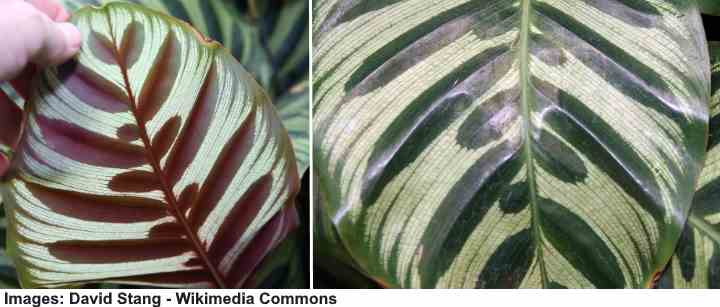
Calathea makoyana plants need humidity levels higher than 60% to grow well indoors
Stunning foliage plants such as Calathea makoyana need above average humidity to thrive indoors. Household air—especially in winter—tends to be too dry for these tropical plants. Getting humidity levels right is key to growing a healthy tropical Calathea. Keeping humidity above 60 percent helps to prevent leaves from turning brown.
Here are some practical ways to increase humidity and encourage healthy peacock plant foliage:
- Mist the broad oval green leaves daily to keep them moist.
- Set the peacock plant on a pebble tray that has water in it half way full.
- Once a week, put the peacock plant under a lukewarm shower to keep leaves humidified.
- Group Calatheas with other houseplants to create a more humid growing environment.
- Use a room humidifier to increase humidity in dry, heated rooms.
How to Fertilize Calathea Peacock Houseplant
Encourage lush foliage by fertilizing a Calathea makoyana every two to four weeks. Use a high nitrogen houseplant fertilizer diluted to half strength. You should apply the fertilizer during the growing season, from spring until early fall. Don’t fertilize the plant during fall and winter when the plant stops growing.
To prevent root burn from a buildup of fertilizer salts, flush the soil every two months. Flushing the soil for a few minutes helps remove any excess minerals accumulated in the potting mix. All you need to do is take the peacock plant pot to a sink and run lukewarm water through the soil for a few minutes. Allow all the water to drain before putting the pot back in its place.
Repotting a Calathea Peacock Plant
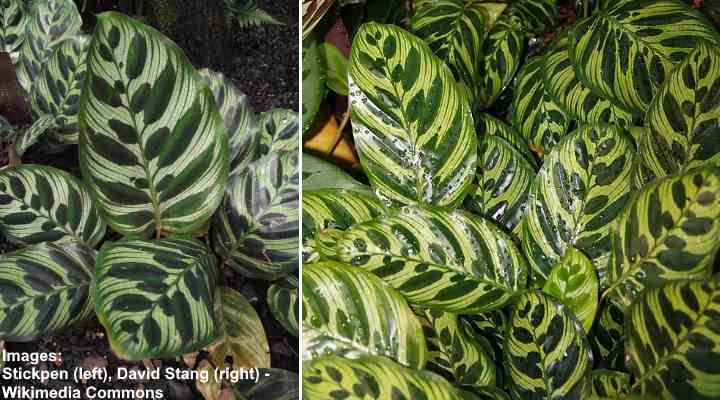
Calathea makoyana plants usually need repotting once every two years
Repot your beautiful peacock plant every two years in spring. Most species of Calathea are sensitive to repotting but don’t grow well if they’re root-bound. When repotting, choose a pot that is one or two sizes up from its current one. Repotting also gives you a chance to check root health and refresh the potting soil.
To repot a peacock plant, carefully remove it from its existing pot. Try to untangle the roots without breaking too many and shake off excess dirt. Check for brown, mushy roots and snip them off as necessary. In the new pot, half-fill it with an appropriate potting mix. Place the peacock plant in the pot, ensuring it’s growing at the same height as before. Fill the remaining space with soil and thoroughly water.
Pruning Calathea Peacock Plants
Calathea makoyana plants only require pruning to remove dead or decaying foliage. The leaves grow on a single stem from the rhizome root. To prune a peacock plant, cut the stems as close as you can to the soil. Then discard the old leaves in the trash. After removing the dead leaves, new growth should appear in its place.
It’s usual for older leaves to turn brown and die. However, suppose you notice that many peacock plant leaves are turning brown. In that case, you’ll need to inspect its growing conditions to find out the underlying cause.
How to Propagate Calathea Makoyana
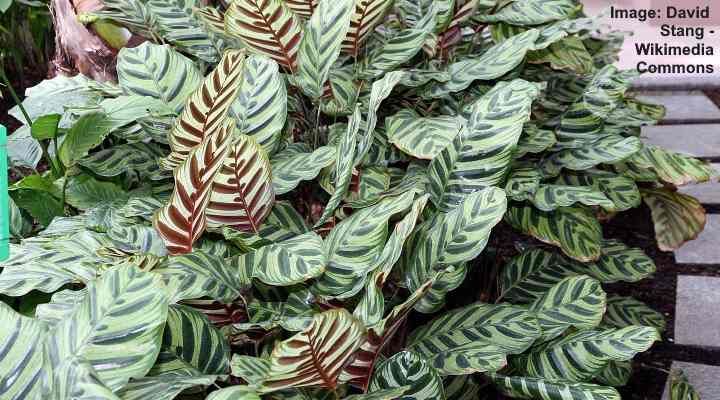
Calathea makoyana can be propagated by root division
Root division is the easiest way to propagate peacock plants. When the Calathea makoyana plant is fully grown, you can divide the rhizome roots into two or three new plants. The best time to propagate peacock plants is when you repot them in spring.
To propagate Calathea makoyana, remove the plant from its container and clean the dirt from the roots. Divide the root into two or three parts, making sure there are a few stems and leaves on each piece. Put the peacock plant in a pot with loose potting soil and keep moist and humid until you see new growth.
Are Calathea Peacock Plants Toxic?
Calathea makoyana plants are not poisonous to cats or dogs. The ASPCA puts plants in the Calathea genus on its list of non-toxic houseplants.
Pests Affecting Calathea Makoyana Growth
Common houseplant pests that can affect peacock plants are aphids, spider mites, and scale insects. Use a homemade neem oil solution to get rid of houseplant bugs. Mix 2 tsp. neem oil and 1 tsp. Castile soap with 1 quart (1 l) lukewarm water. Mix well in a spray bottle and thoroughly douse the variegated foliage with the natural pesticide.
Depending on the infestation size, you’ll need to apply the plant pest control solution regularly. Once a week, spray the neem oil insecticide on the foliage and leave it to dry for best results.
Related reading: How to spot the signs of common houseplant pests and Natural ways to get rid of houseplant bugs.
Diseases Affecting Peacock Plant Growth
Root rot caused by overwatering is the most common type of disease affecting Calathea makoyana. The problem with root rot is that damage occurs before you notice it. When leaves start to wilt, turn yellow, and become mushy, the chances are that the roots are rotting in soggy soil. The best way to save your plant is to repot it in fresh potting soil.
To prevent root rot disease, always water peacock plants when the soil is partially dry.
FAQ About Peacock Plant Care
Even though Calathea makoyana plants are easy to care for indoors, there are a few signs that you need to check the growing conditions.
Why do Calathea Makoyana leaves curl?
Leaf curling on calathea plant, including calathea peacock, is usually a sign that it lacks water. If the plant leaves have curled, check the soil for dryness. If the potting mix is dry, thoroughly drench the potting soil of the Calathea makoyana and allow the excess water to drain.
Why do my peacock plant’s leaves have brown tips?
The common reasons for beautiful peacock plant leaves getting brown tips are lack of humidity, too much direct sunlight, or standing in a draft. Try to identify which of these reasons is causing brown Calathea leaves and adjust your care techniques appropriately.
Why is my Calathea droopy?
A Calathea with wilting leaves can indicate several care problems. If the temperature is too cold or the plant is in a draft, leaves will start to droop. Move the plant to a warmer location away from cold air.
However, limp stems that are mushy near the soil are a sign of severe root rot. In this case, you’ll have to take swift action to remove any dead roots and save your plant.
How do you revive a dying Calathea peacock plant?
The only way to save a dying peacock plant from root rot is to remove any decaying, mushy roots. Unfortunately, if the decay is extensive, it may not be possible to save your plant.
Related articles:
